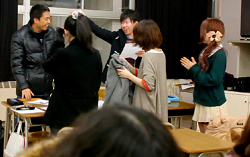Overcoming limitations of contingency approach to classroom management
Merriam [5] pointed to a limitation of Grow's model, saying it "has been criticized for having a blinding focus on the individual learner while ignoring the socio-historical context in which [learning] occurs" [5, p. 11]. Groups rarely exhibit functional homogeneity among members; student groups are typically composed of individuals with varying degrees of skills, abilities, and motivations. Fortunately, learning team models seem to provide a strategy for implementing contingency approaches that meet individual student needs while aligning classroom activities to developing all students' needs.
A learning team model develops individuals to take responsibility for their own learning, then enhance their knowledge by creating a small team of students. In turn, the team members engage in accomplishing the team's goals while helping individuals achieve their own goals. The team then contributes to developing the entire class, contributing to developing the members of each team in the class.
Integrating contingency approaches with a collaborative learning model may help faculty build high-performance learning environments. They can apply "multi-gogical" or integrative teaching methods that allow all students to engage in individual and collaborative learning to accelerate academic development toward self-direction. The learning team model also allows learners to build a social network of students with similar skills. This allows faculty to deliver personalized teaching methods to smaller groups within the classroom.
Another important consideration of contingency approaches to adult-classroom management is that individual needs tend to be dynamic. Human needs adjust depending on factors both internal and external to the learner [6].
For example, students who are self-directed in a management course may find themselves struggling to grasp a math course. The Staged-Self-Direction Model shows that the math teacher must take a more directive teaching style than the management teacher took.
However, even when teachers find themselves matched with the right type of learner, they still need to have the ability to apply different approaches to instructions. For example, self-directed learners matched with a facilitator may not have the patience to deal with the slow pace at which learning can unfold in a facilitated learning environment. Self-directed learners may want that faculty to just get to the point rather than play games all night.
Taylor, Marienau, and Fiddler [7] offered an additional caveat for faculty who want to act as pure delegators in a collaborative environment: self-directed learners "may feel shortchanged when an educator explains that she intends to be less a source of answers than a resource for learning" [7]. In other words, adult learners may want their instructors to deliver value, not just delegate.
In short, dynamic and diverse student needs require that the instructor build a flexible leadership style and a versatile toolkit for building a dynamic learning environment in which learners can recognize the value, regardless of their learning stage.




